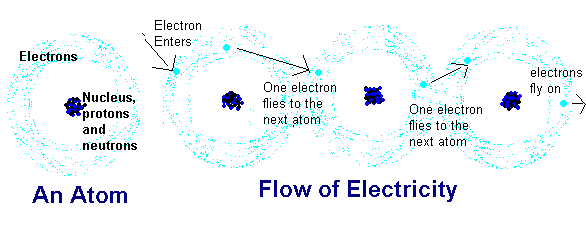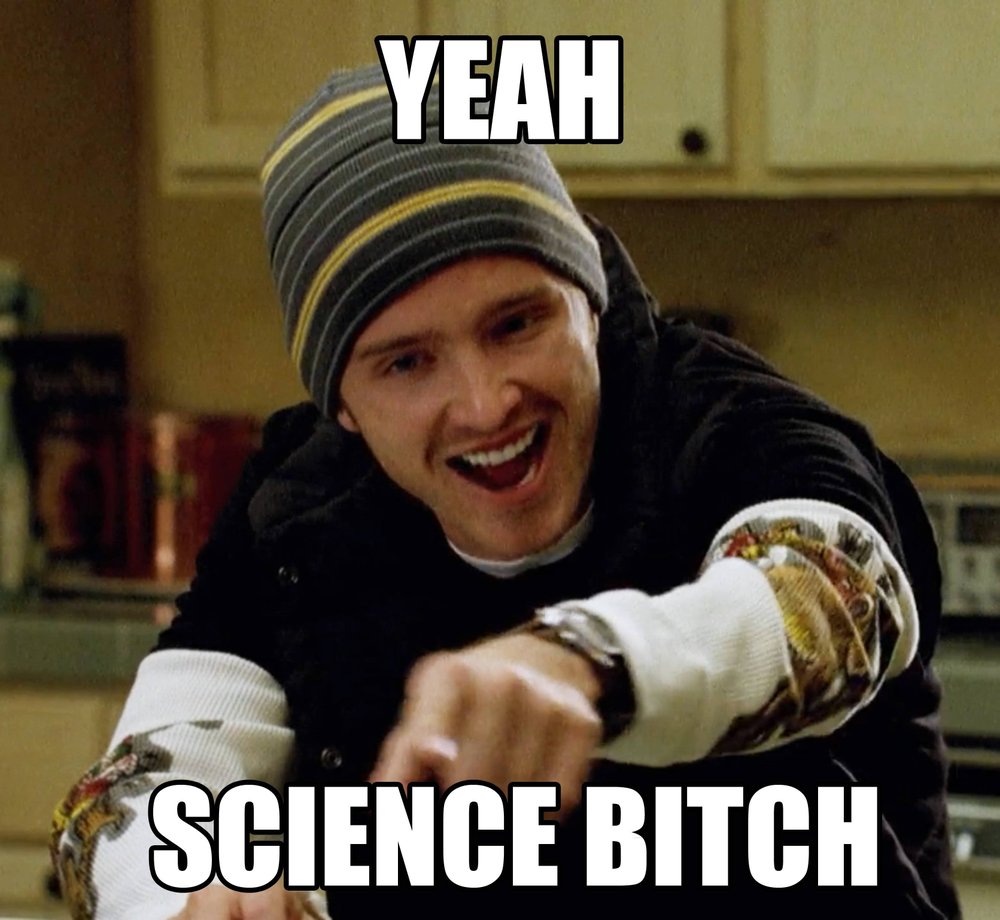- This topic has 71 replies, 40 voices, and was last updated 8 years ago by andyl.
-
Electricity – it just struck me…
-
Malvern RiderFree MemberPosted 8 years ago
I’m in my forties and don’t know what the hell it is.
Here’s a challenge:
Write a paragraph below, describing electricity exactly as you understand it. No cheating! No referencing. (I’ll know!)
Here’s mine:
Stuff in the air with a charge in it. What the hell a charge is I don’t know.
madhouseFull MemberPosted 8 years agoisn’t it the movement of electrons? works in a similar way to osmosis, positive has lots of them and they ‘flow’ to the negative.
or maybe I can’t remember what went on in physics either.
TheBrickFree MemberPosted 8 years agoI’d say somethign along the lines of.
Electricity is the flow of electrons through a conductive medium casue by a combination of differing atomic potential energies and or movment of said conductor through a magnetic field.CougarFull MemberPosted 8 years agoIf you really want to break your head,
Electricity ‘flows’ from positive to negative, however the actual physical movement of electrons goes from negative to positive. So a battery in effect sucks rather than pushes.
hopeychondriactFree MemberPosted 8 years agoAs long as I can visit stw site then I couldn’t give a cheesy wotsit.
nemesisFree MemberPosted 8 years agoisn’t it the movement of electrons? works in a similar way to osmosis, positive has lots of them and they ‘flow’ to the negative.
As Cougar pointed out, when they were working out which was positive and which was negative (the idea being that “electricity” flowed from +ve to -ve but they couldn’t actually do a test to check), they took a 50:50 punt and got it the wrong way round…
TheBrickFree MemberPosted 8 years ago@Cougar. I always took the +ve to -ve thing as just circuit current rather than “true current” as it howe the electrons are flowing as circuit current was just a useful anology used to liken the flow electricity to that of water from high potential / pressure to low potantial / pressure. I know there is the the idea of representing the flow of electron holes but I’ve never really liked that anology.
bikebouyFree MemberPosted 8 years agoIt’s the combination of Pixies and Aliens fighting in NooNoo Dust Clouds just above the Moons atmosphere, the Clangers could see them, you/we can’t.
HTH
TheBrickFree MemberPosted 8 years agoYou will need to brush up on your differnetial geometry to learn about gravity.
nemesisFree MemberPosted 8 years agoThe electron was discovered by J. J. Thomson in 1897 but for much more than a century before that moment, people had already been studying electric (and magnetic) phenomena, even quantitatively, and they had already fixed some convention which charged objects or sides of a battery are positive and which of them are negative.
Because this convention was already established, there was absolutely no freedom in the decision about the sign of the electron’s charge. It was simply measured in the cathode rays etc. and it turned out to be negative.
Historically, the first man to decide about a sign convention for the electric charge was probably Benjamin Franklin in the 18th century. His model of electricity assumed that charged objects contain some fluid – it’s the electric charge of a continuous type (the similarity with phlogiston, the fluid that was believed to personify heat, can’t be overlooked). If there’s too much of this fluid, which is naturally identified with the plus sign, he would talk about the positive electric charge and vice versa.
Up to the moment when the elementary particles were being discovered, there was no way to prove that one of the two sign conventions was better than others. In fact, even today, it’s not true that the opposite sign convention would be “better” in any sense. Electrons could carry a positive charge in the opposite convention but protons and nuclei (and up quarks) that are equally important (and, in the case of up quarks, equally fundamental) would be negatively charged while they’re nicely positively charged in the world around us.
Once a convention is fixed for the electric charge, a natural convention emerges for the sign of the current, voltage, and many other electric observables, too. It just happens that in the circuits, the arrows for the current have the opposite direction than the velocities of the electrons but this discrepancy only became visible once people knew that the currents was composed of the negatively charged electrons which was a long time – a century – after Benjamin Franklin’s setting of the convention. This apparent discrepancy causes no problems as long as we carefully follow it and realize (and, when necessary, emphasize) that the arrows represent the current according to the established conventions and not the electrons’ velocity.
One should also point out that there exist conductors where the conductivity is guaranteed by positively charged carriers (or both), for example in solutions (positively charged ions) or semiconductors (holes). In those conductors, the signs of the current agree with the sign of the velocity of the (positively charged) carriers.
versesFull MemberPosted 8 years agoMovement of electrons… Where are they moving and how?
Google tells me an Electron is “a stable subatomic particle with a charge of negative electricity, found in all atoms and acting as the primary carrier of electricity in solids.”
So are they moving from one atom to another? Because that would hurt my brain a bit if they are… Surely stuff in an atom is pretty well contained?
martinhutchFull MemberPosted 8 years agoJust summarise it in 14 words or fewer, like a good candidate would. 🙂
CougarFull MemberPosted 8 years agoas circuit current was just a useful anology
My understanding was that it was picked arbitrarily before they actually knew about electron flow. Whether or not that’s an urban myth though, I’m not sure.
nickjbFree MemberPosted 8 years agoElectricity isn’t any one thing; its a general term that covers a pretty broad spectrum.
BigButSlimmerBlokeFree MemberPosted 8 years agoNever mind that. How does gravity work?
Electricity. Switch all the electricity off and we’d be able to fly. Like dinosaurs did.
mogrimFull MemberPosted 8 years agoSo are they moving from one atom to another? Because that would hurt my brain a bit if they are… Surely stuff in an atom is pretty well contained?
Protons and neutrons are (that’s nuclear physics). The electrons are the swingers of the atomic world, though.
NorthwindFull MemberPosted 8 years agoCougar – Moderator
Electricity ‘flows’ from positive to negative, however the actual physical movement of electrons goes from negative to positive. So a battery in effect sucks rather than pushes.
I discovered this in physics class, by answering all the questions in a test wrong and subsequently breaking the teacher’s head when she came to mark it, as she couldn’t tell if I was really advanced or really stupid.
stumpy01Full MemberPosted 8 years agoI understand it as a movement of electrons – and for that to occur you have to have a quantity of ‘free electrons’. So conductors like most metals have free electrons, whereas most plastics have no free electrons so are insulators.
Cougar – Moderator
If you really want to break your head,
Electricity ‘flows’ from positive to negative, however the actual physical movement of electrons goes from negative to positive. So a battery in effect sucks rather than pushes.
I’m probably wrong, but I thought this was just a convention thing….that in the early days of electricity, people assumed that the flow was from positive to negative and this has just stuck. But the actual flow of electrons is from negative to positive (as they are negatively charged, so slow towards the positive end of a circuit).
There’s quite a good description of what I mean on Wikipedia:
Conventions
In metals, which make up the wires and other conductors in most electrical circuits, the positively charged atomic nuclei are held in a fixed position, and the electrons are free to move, carrying their charge from one place to another. In other materials, notably the semiconductors, the charge carriers can be positive or negative, depending on the dopant used. Positive and negative charge carriers may even be present at the same time, as happens in an electrochemical cell.A flow of positive charges gives the same electric current, and has the same effect in a circuit, as an equal flow of negative charges in the opposite direction. Since current can be the flow of either positive or negative charges, or both, a convention is needed for the direction of current that is independent of the type of charge carriers. The direction of conventional current is arbitrarily defined as the same direction as positive charges flow.
The consequence of this convention is that electrons, the charge carriers in metal wires and most other parts of electric circuits, flow in the opposite direction of conventional current flow in an electrical circuit.
shermer75Free MemberPosted 8 years agoSo. When electricity is flowing through a liquid, is it still electrons flowwing from one end to another or is it the ions? Or a bit of both? I seem to remember a chemist teacher telling me that all the ions will eventually end up at one end, which confused me!
seadog101Full MemberPosted 8 years agoOn the silly -ve and +ve electron flow, I’ve always thought of it like this:
The battery is losing the electrons through the -ve end, so therefore getting less so that’s why negative?
Oh hang on, electrons have a -ve charge, so if you’re losing a negative that makes you positive, so that doesn’t make sense anymore… damn it.
bencooperFree MemberPosted 8 years agoJust don’t start asking yourself how some solids are transparent and other very similar ones aren’t. Or why where’s no transparent metals 😉
Having to explain this stuff to a curious 5-year-old is fun…
shermer75Free MemberPosted 8 years agoSo this article seems to suggest that it’s the ions drifting to their respective electrodes (cations to the -ve, anions to the +ive ends) and that the electrons do not move, as they would in a solid metal for example. So there must come a time when all the cations are at one end and the anions at the other, right? And therefore the liquid will no longer conduct electricity?
GrahamSFull MemberPosted 8 years agoIf you really want to break your head,
Electricity ‘flows’ from positive to negative, however the actual physical movement of electrons goes from negative to positive.
Someone tried to explain to me once that the electron flow model is also a simplification and, possibly depending on the source of the electricity, you also get electron hole flow or something…
…my brain pretty much shut down at that point.
lerkFree MemberPosted 8 years agoThink of scooby-doo backgrounds and you’ll see why the current vs electron movement works 😉
hilldodgerFree MemberPosted 8 years ago“Electricity” is a term used to describe several phenomena associated with the presence & movement of electric charge – you really need to specify if you are referring to charge, field, potential or current when discussing electrickery in any detail
nickcFull MemberPosted 8 years agoI would explain it as a series of properties defined by the physics of some particles to have forces that will interact with other particles that will under certain circumstances produce currents, fields and magnetism.
probably wildly wrong though
CougarFull MemberPosted 8 years agoyou also get electron hole flow or something…
Line up a row of pennies.
Move the rightmost one right a bit. Move the next one to the place the other one just was. Repeat down the line.
The pennies are all moving to the right. But the gap moves left.
TheBrickFree MemberPosted 8 years ago@verses. Electrons exist in differnet spaces / orbits / energy levels around a atom, depending on the struture of the atom there are diffrent probablities of where thoese electrons may be in diffrent shaped clouds. If two atoms can gain a lower energy level by sharing or allowing an electon to move between each of their orbits there by changing the shape of these electns outermost orbits so the probility of finding that electron in either of these two orbits. This forms a bound between the two attom. Simarly if one atom if more potivly charged than the other the same altering of the probabilty space of where the electon lies is alter making a differenet type of bond. So electons are free to move between attoms. This is not electcity but shows how electons can be shared.
andytherocketeerFull MemberPosted 8 years agoelectron hole flow makes more sense when talking about semiconductors. even then it’s not really flow along a wire in the conventional sense but distribution of holes and electrons as a result of the doping of the semiconductors and the charges and potentials applied.
bencooperFree MemberPosted 8 years agoSomeone tried to explain to me once that the electron flow model is also a simplification and, possibly depending on the source of the electricity, you also get electron hole flow or something…
…my brain pretty much shut down at that point.
Imagine one of those automatic sweet making machines, which have a conveyor belt with lots of little moulds on it, hot sugary stuff goes into the moulds at one end, travels along cooling down, and cool sweets drop out at the other. Then the conveyor wraps underneath and the empty holes flow back to the beginning.
Holes flow one way, electrons/sweets flow the other.
😀
richmtbFull MemberPosted 8 years agoSomeone tried to explain to me once that the electron flow model is also a simplification and, possibly depending on the source of the electricity, you also get electron hole flow or something…
Most semi conductors work in this way. I think?
Just don’t ask me to explain quantum tunneling
The topic ‘Electricity – it just struck me…’ is closed to new replies.



